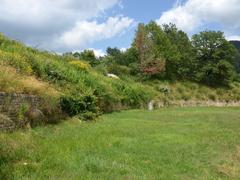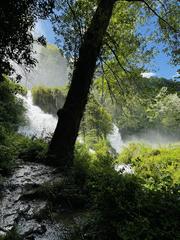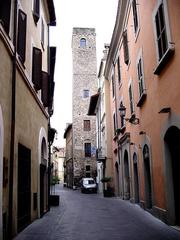Rocca di Piediluco: Visiting Hours, Tickets, and Historical Sites in Terni, Italy
Date: 14/06/2025
Introduction
Rising atop Monte Caperno and overlooking the shimmering Lake Piediluco, the Rocca di Piediluco is one of Umbria’s most iconic medieval fortresses. This site, deeply rooted in the political and cultural history of Terni, offers not just a journey through centuries of architecture and power struggles but also panoramic vistas and a vibrant connection to the surrounding landscape. Whether you are a history enthusiast, a lover of medieval architecture, or simply drawn to scenic destinations, the Rocca di Piediluco promises an enriching experience.
This comprehensive guide covers the fortress’s historical evolution, distinctive architectural features, cultural significance, essential visitor information—including current visiting hours, ticketing, accessibility, and travel tips—as well as nearby attractions and practical advice for making the most of your visit. Up-to-date information ensures a seamless trip for all travelers (Comune di Terni; Visit Umbria; UmbriaOn).
Historical Overview
Origins and Early History
The origins of Rocca di Piediluco trace back to a sacred forest on Monte Luco, which became home to Castello di Luco in the early Middle Ages. By 1028, the site was incorporated into the feudal holdings of the Arroni family and later given to the Abbey of Farfa, reflecting the region’s shifting power dynamics (Festa delle Acque). In the 13th century, the Brancaleoni family controlled the castle, which became a focal point in the regional conflicts between Guelphs and Ghibellines as well as disputes among Terni, Rieti, and Spoleto. Repeated sieges led to the destruction of the original fortification.
Albornoz Reconstruction and Papal Power
Between 1364 and 1368, the current Rocca was constructed atop the ruins of its predecessor under the leadership of Blasco Fernandez di Belvisio, a relative of Cardinal Egidio Albornoz. The fortress became part of a network of “Albornozian fortresses,” representing the resurgence of papal authority in central Italy after decades of instability (Comune di Terni). This period marked a definitive assertion of Guelph dominance and a new chapter in the Rocca’s history.
Architectural Features
Rocca di Piediluco stands out for its unique configuration among Albornozian fortresses. The structure comprises two main elements: the military-defensive “Rocca” and the residential “Palazzo dei Brancaleoni.” The pentagonal donjon (mastio), which rises five stories, is a central feature. Its lowest level served as a water reservoir, essential during sieges, with a cistern in the central courtyard to collect rainwater.
Unlike the typical quadrangular layout of other Albornozian fortresses, Rocca di Piediluco features a linear plan joining the donjon, courtyard, and palace. Defensive walls and towers—some now obscured by dense 20th-century vegetation—once encircled the complex (Comune di Terni).
The 13th-century Brancaleoni palace, updated during the 14th-century reconstruction, retains its reception hall, living quarters, and a main entrance adorned with small lion sculptures, a motif also seen in the nearby Church of St. Francis.
Cultural and Religious Context
Piediluco has long bridged sacred and secular traditions. The area transitioned from pagan rituals to a center of Christian devotion, underscored by the construction of the Church of St. Francis in 1338 (LakeLovers). The fortress, with its commanding views, has become a symbol of resilience and spiritual significance, embodying the region’s layered history since the arrival of St. Francis of Assisi.
Notable Events and Modern History
After its 14th-century reconstruction, the Rocca served as a key administrative and defensive center. As military needs evolved, its strategic role diminished, and the fortress gradually fell into ruin. Since the 20th century, ongoing preservation and restoration efforts have aimed to stabilize and showcase the fortress, including recent initiatives to improve visitor safety and interpretive content (UmbriaOn). The Rocca is also a centerpiece of local cultural events, such as the annual Festa delle Acque (Festa delle Acque).
Visitor Information
Location and Getting There
The Rocca di Piediluco is located just 15 km from Terni, accessible by car, bus, or foot. Parking is available in Piediluco village, with a well-marked footpath leading to the fortress. Public buses from Terni connect to Piediluco (about 19 minutes), and the scenic hike from the village center to the Rocca takes approximately 20–30 minutes (Rome2Rio, Il Borgo Sul Lago).
Visiting Hours
- Current Schedule (2025): The fortress grounds are generally open from dawn to dusk year-round. Interior access may be restricted during restoration; check official sources for updates (UmbriaOn).
- Best Times to Visit: Early morning and late afternoon provide cooler temperatures and ideal lighting for photography.
Tickets and Guided Tours
- Admission Fee: As of June 2025, access to the exterior and panoramic areas is free. After restoration, an entrance fee may apply.
- Guided Tours: No official guided tours are currently offered, but local tourism offices can arrange private guides, especially during festivals or for groups (Comune di Terni).
Accessibility
- The path to the fortress is unpaved and moderately steep, requiring sturdy footwear. It may not be suitable for visitors with limited mobility or strollers. Restoration plans include future improvements to accessibility.
Facilities
- Restrooms: Available in Piediluco village, not at the Rocca.
- Food and Drink: Bring water and snacks. Local restaurants and cafés in the village offer traditional Umbrian fare (Trip.com).
- Picnic Areas: Picnicking is permitted around the Rocca; visitors are expected to carry out all litter.
What to See and Do
The Fortress Experience
- Pentagonal Keep: Explore the remains of the striking five-story mastio and panoramic viewpoints.
- Medieval Walls: Walk among the partially hidden defensive walls and towers.
- Palazzo dei Brancaleoni: Admire the restored reception hall and unique architectural details.
- Photography: Capture spectacular views of Lake Piediluco and the Apennines, especially at sunrise or sunset.
Scenic Hiking and Outdoor Activities
- Trail to the Rocca: Enjoy a rewarding hike through pine and holm oak forests, with interpretive panels along the route (Travalour).
- Nearby Trails: Extend your adventure on longer routes leading to Cascata delle Marmore or through Parco Fluviale del Nera.
Cultural Events and Festivals
The Rocca di Piediluco is a focal point for local festivals, most notably the Festa delle Acque—a celebration of the lake and its traditions, featuring music, parades, and historical reenactments (Festa delle Acque). The annual “Festa della Rocca” brings medieval-themed pageantry and community gatherings to the fortress grounds.
Practical Tips
- Footwear: Wear sturdy shoes for uneven terrain.
- Weather: Prepare for temperature changes; summer can be hot, while evenings and winter are cooler.
- Sun Protection: Bring sunscreen and a hat.
- Safety: Follow all posted signs and respect restricted areas during restoration.
- Wildlife: Enjoy but do not disturb the local flora and fauna.
Nearby Attractions
- Lake Piediluco: Renowned for rowing, kayaking, and boat tours (Italia.it).
- Villalago: A 19th-century villa and public park hosting summer concerts (Il Borgo Sul Lago).
- Cascata delle Marmore: One of the tallest man-made waterfalls in the world (The Crazy Tourist).
- Village of Piediluco: Explore the historic center with marine-themed alleys, local art installations, and the Church of San Francesco (Atlas Obscura; Souvenir di Viaggio).
Frequently Asked Questions (FAQ)
Q: What are the Rocca di Piediluco visiting hours?
A: The site is generally open from dawn to dusk, but consult official sources for restoration-related updates.
Q: Is there a ticket fee?
A: Currently, exterior and panoramic areas are free to access. Fees may be introduced after restoration.
Q: Are guided tours available?
A: No regular tours at present, but local offices can help arrange private guides.
Q: Is the Rocca accessible for people with mobility issues?
A: Access is limited; the path is unpaved and moderately steep.
Q: How do I reach Rocca di Piediluco?
A: By car, bus (from Terni), or a scenic walk from Piediluco village.
Responsible Tourism
Help protect this historic landmark by keeping to marked paths, respecting restoration areas, and carrying out all waste. Your care preserves the Rocca for future generations (UmbriaOn).
Additional Resources
- Official Information & Updates: Comune di Terni – Rocca di Piediluco
- Tourism Guides: Visit Umbria – Rocca di Piediluco
- Restoration News: UmbriaOn – Rocca di Piediluco Restoration
- Cultural Events: Festa delle Acque – Rocca di Piediluco
For more information, download the Audiala app for offline maps, event schedules, and up-to-date travel tips. Follow us on social media for news and highlights about Rocca di Piediluco and other Terni historical sites.



